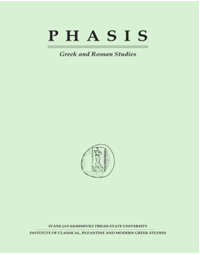Érasme et l'Antiquité: de l'usage des Adages dans sa Paraphrase sur Matthieu
DOI:
https://doi.org/10.48614/phasis.18.2015.48-65Abstract
This paper discusses one feature of Erasmus’ use of the Latin language by demonstrating how the humanist relied upon his own Adagia, a nearly endless sum of classical sayings that mirrored their author’s “farsighted” approach to Antiquity when composing the Paraphrases. Evidence drawn from the Paraphrase of the Gospel of Matthew sheds light on this particular approach. Having illustrated (I) the relation between Erasmus’ Paraphrases and those of his classical and avowed forerunners (Themistius and Juvencus), and having discussed (II) their author's poiesis in rewriting and glossing the Gospel, this paper provides (III) an in-depth analysis of nine Adagia quoted in the Par. in Mt. According to my reading, those would have been put to four different uses: (A) simple direct use; (B) amplified direct use;(C) indirect use; and (D) amplified indirect use. Thus, this analysis – that should be applied to the whole of the Paraphrases – allows us to see that Erasmus did not treat the Adagia as fixed locutiones that would impede further Latin composition, but as a treasure of sentences and literary images readily available to all writers in order to lift their spirits and their works. Additionally the analysis shows the tight bound rhetoric that links the Adagia and the Paraphrases, sharing the same educational goal: translating (following the Latin meaning of transducere) the pagan and Christian classical culture for the benefit of the humanist dream of a universal, evangelical and Latin Christendom.Downloads
Published
2015-02-16 — Updated on 2024-08-18
Versions
- 2024-08-18 (2)
- 2015-02-16 (1)
Issue
Section
Articles
License
Copyright (c) 2015 PHASIS

This work is licensed under a Creative Commons Attribution-NonCommercial 4.0 International License.


